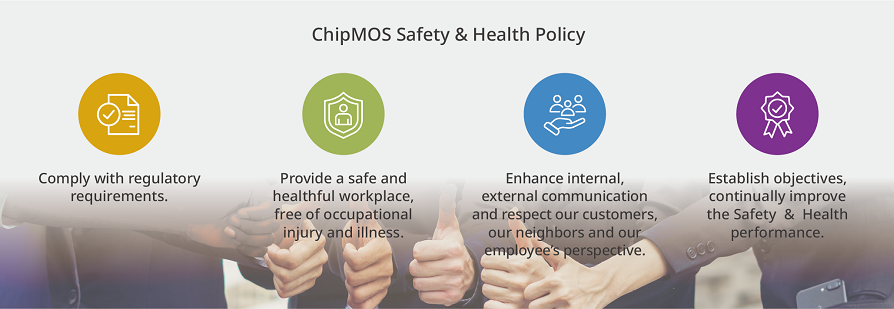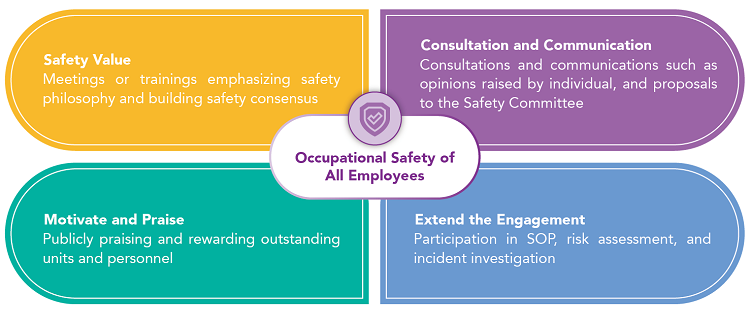Safe Working Environment

▪ ChipMOS Safety and Health Policy
ChipMOS attaches great importance to the safety and health issues of employees and non-employees who are active in the factory. Only a safe and hygienic working environment can allow all workers to work with peace of mind and create high efficiency and high-quality work performance. We adopt a systematic management model, all factories continue to promote the ISO 45001 occupational safety and health management system, and through third-party verification, the implementation of work environment safety and health management operations and in line with international management trends. The coverage of the management system includes the routine and non-routine activities of all workers in the factory, as well as the safety and health risks that may be derived, covering 100% of the scope.
Environmental Safety, Health and Energy Management Committee
In the promotion of sustainability and occupational health and safety at ChipMOS, we adopt a top-down strategy for planning and execution. Each fab has established an Environmental Safety, Health and Energy Management Committee with the Executive Vice President responsible for promotion and implementation of relevant goals and programs. The Committee is chaired by tier-one managers, with the department managers and committee members actively participate in regular committee meetings held every three months in accordance with the law. The labor representatives constitute more than one-third of the total committee members and are elected through an open selection process involving the employees.
Create Occupational Safety of All Employees

Each year, relevant training is planned according to the Work Safety and Environmental Protection Education Training Operation Guide, and different trainings are conducted based on the nature of workers, including general safety and health education, personnel operating hazardous machinery or equipment, special operation personnel, and occupational health service nurses. For contractors, the Contractor Safety, Health and Environmental Protection Management Regulations are followed to implement job safety and health education training, enhancing workers' awareness of safety and hygiene.
Building a Healthy and Safe Supply Chain
ChipMOS is committed to building a healthy and safe supply chain, strengthening management and enhancing safety awareness for non-employee workers, and promoting supply chain health and safety capabilities through supplier audits and regular contractor meetings, thereby exerting corporate influence and achieving mutual benefits.
ChipMOS responds to the "Sustainable Leadership Enterprise for Healthy Labor Force" activity of the Occupational Safety and Health Administration, inviting 32 supply chain manufacturers to complete self-assessment tasks on the OSH Sustainable Performance Self-Assessment Platform of the Ministry of Labor's Occupational Safety and Health Administration. By requiring suppliers to review their management performance in human rights, occupational safety and health, this initiative aims to promote a ripple effect throughout the value chain, embodying the spirit of large enterprises supporting smaller ones while helping the company grasp supply chain risks and providing timely assistance and support.